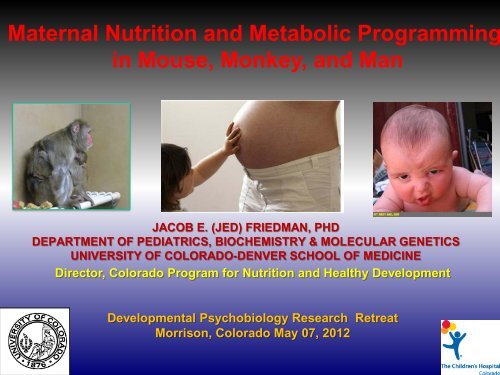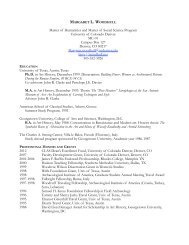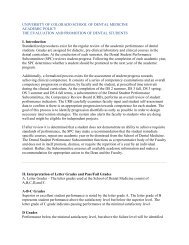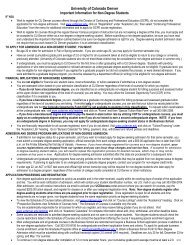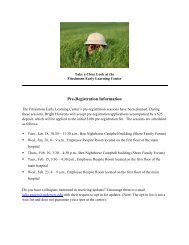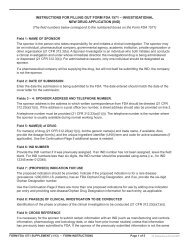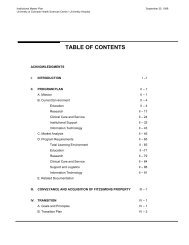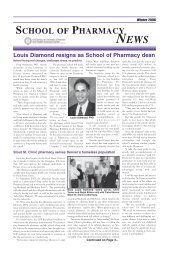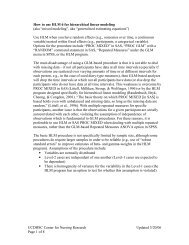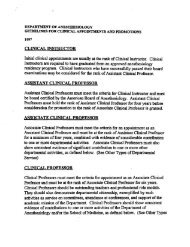Presentation - University of Colorado Denver
Presentation - University of Colorado Denver
Presentation - University of Colorado Denver
You also want an ePaper? Increase the reach of your titles
YUMPU automatically turns print PDFs into web optimized ePapers that Google loves.
Maternal Nutrition and Metabolic Programming<br />
in Mouse, Monkey, and Man<br />
JACOB E. (JED) FRIEDMAN, PHD<br />
DEPARTMENT OF PEDIATRICS, BIOCHEMISTRY & MOLECULAR GENETICS<br />
UNIVERSITY OF COLORADO-DENVER SCHOOL OF MEDICINE<br />
Director, <strong>Colorado</strong> Program for Nutrition and Healthy Development<br />
Developmental Psychobiology Research Retreat<br />
Morrison, <strong>Colorado</strong> May 07, 2012
Acknowledgements:<br />
Oregon National Primate Research Ctr<br />
Kevin Grove, Ph.D.<br />
Dan Marks, MD, Ph.D.<br />
Antonio Frias, MD, PhD<br />
Diana Takahashi, MS.<br />
Staff and support Oregon National Primate<br />
Research Center, Beaverton Oregon<br />
NIH-RO1 DK060685, RO1 DK074643,<br />
R24 DK90964, P30 DK048520 , ADA<br />
<strong>University</strong> <strong>of</strong> <strong>Colorado</strong> Nutrition & Obesity<br />
Research -Center (NORC); <strong>University</strong> <strong>of</strong> <strong>Colorado</strong><br />
Maternal-Child Clinical Translational Research<br />
Center<br />
<strong>University</strong> <strong>of</strong> <strong>Colorado</strong>-<strong>Denver</strong><br />
Center for Proteomics:<br />
�Karen Jonscher, Ph.D.<br />
�Aga Kendrick, M.S.<br />
Baylor College <strong>of</strong> Medicine:<br />
Kjersti Agaard-Tillery, M.D. Ph.D.<br />
<strong>University</strong> <strong>of</strong> <strong>Colorado</strong>-<strong>Denver</strong><br />
Carrie McCurdy, Ph.D.<br />
Stephanie Thorn, Ph.D.<br />
Lynn Barbour, M.D.<br />
Teri Hernandez, Ph.D.<br />
Margaret Heerwagen, B.S.<br />
Becky De La Houssaye, M.S.<br />
Rachel Van Pelt, Ph.D.<br />
Michael Stewart, M.D.<br />
Sean Newsom, Ph.D.<br />
Kristen Boyle, Ph.D.<br />
David Brumbaugh, M.D.<br />
Rachel Janssen, M.S.<br />
Rebecca Aiken, M.S.
<strong>Colorado</strong> Program in Nutrition and Health Development<br />
Jed Friedman, Director, Lynn Barbour-Co-director<br />
Goals <strong>of</strong> the Program:<br />
• To understand basic mechanisms underlying the role <strong>of</strong><br />
nutrition and the environment on maternal-infant health in<br />
animal models that can be translated to humans.<br />
• To develop safe nutritional/interventional strategies to<br />
achieve a healthier pregnancy and improve newborn health<br />
during the first 1000 days <strong>of</strong> life.<br />
• To facilitate collaborative research within <strong>Colorado</strong> and<br />
beyond.<br />
• To provide education for trainees, medical pr<strong>of</strong>essionals, and<br />
the lay public.
<strong>Colorado</strong> Program for Nutrition and Healthy Development
Outline <strong>of</strong> Talk:<br />
1) The new science <strong>of</strong> Fetal Programming<br />
- Fetal Programming: What is it?<br />
- Maternal Obesity and the fetus:<br />
Response to an Epidemic<br />
2) Studies in Non-Human Primate<br />
3) Studies in Human pregnancy<br />
4) - Omega-3’s<br />
- Fat-1 mouse model<br />
5) Future Directions
Fetal Programming:<br />
The intrauterine environment can<br />
impact fetal development at both<br />
a morphological and a molecular<br />
level.<br />
An “adverse” environment can<br />
predispose an infant to later life<br />
diseases, such as obesity,<br />
diabetes, and CVD.
Oct. 6, 2010
How Big Is the Problem?<br />
% Women with BMI > 30<br />
(OBESE) (Overweight)<br />
Catalano OM, Ehrenberg HM. BJOG. 2006 Oct;113(10):1126-33.
March 18, 2010<br />
700,000 children and teens (2-19) in Southern California<br />
1/6 <strong>of</strong> children are obese (>95%)<br />
7% boys and 5% girls extremely obese<br />
“These kids face 10-20 years shorter life span and will<br />
develop health problems in their 20s that we typically see<br />
in 40-60 yr olds”<br />
Fatty Liver Disease in Obese Youth: 1 in 5.
Trends in child and adolescent overweight<br />
Age 6-11<br />
Age 12-19<br />
Age 2-5<br />
Note: Overweight is defined as BMI>=gender and weight-specific 95th percentile from the 2000 CDC<br />
Growth Charts. Source: National Health Examination Surveys II (ages 6-11) and III (ages 12-17),<br />
National Examination Surveys, I, II, III and 1999-204, NCHS, CDC.
World-Wide Childhood Obesity Epidemic<br />
Critical Early Life Factors affect Health<br />
Across the Lifespan<br />
Genes Gestational Exposure Post-natal Environment<br />
The Childhood Obesity Pipeline is Full and getting worse
NIH Consensus Conference,<br />
Sept 23-24, 2005 Bethesda MD<br />
The Maternal Intrauterine Environment and<br />
the Origins <strong>of</strong> Obesity<br />
• When does it Occur?<br />
• How does it Occur?<br />
• What can we do about it?<br />
“Programming” effects on Obesity, CV-disease, and Cancer
Prevalence (%)<br />
Prevalence <strong>of</strong> Type 2 DM In Pima Indians,<br />
by Mothers Diabetes in Pregnancy<br />
75<br />
60<br />
45<br />
30<br />
15<br />
0<br />
Offspring <strong>of</strong> non-diabetic mothers<br />
Offspring <strong>of</strong> pre-diabetic mothers<br />
Offspring <strong>of</strong> diabetic mothers<br />
5-9 10-14 15-19 20-24 25-29 30-34<br />
Age (years)<br />
Dabelea D, Pettitt DJ, J Mat. Fetal Med. 2000; 9:83.
Development is characterized by early windows <strong>of</strong> plasticity:<br />
.<br />
Cells in this window are highly sensitive to environmental stimuli that impact:<br />
- differentiation<br />
- death/proliferation<br />
- gene expression programs<br />
Fowden A L et al. Physiology 2006;21:29-37
The “Obese Environment”<br />
• Adipose Tissue Hypertrophy<br />
• Insulin Resistance<br />
• Hyperlipidemia<br />
• Hyperglycemia<br />
• Hyperinsulinemia<br />
• Inflammation<br />
But we see this kind <strong>of</strong> metabolic pr<strong>of</strong>ile somewhere else too…
Metabolic changes during pregnancy:<br />
In the mother, in order to mobilize energy stores<br />
and fuel fetal growth:<br />
Hyperlipidemia<br />
Hyperglycemia<br />
Insulin Resistance<br />
Adipose Hypertrophy<br />
What happens when obesity and pregnancy combine?
When the two combine: Maternal Obesity<br />
Significant evidence here<br />
Heerwagen et.al. AJP Review September 2010
Long Term Implications for Fetus<br />
• Obese infants are up to 2-9 times<br />
as likely to be obese as adults Baird J,<br />
BMJ 2005;331:929<br />
• Maternal BMI ≥ 30 conferred 25%<br />
obesity risk at age 4 (~3-fold) indep<br />
<strong>of</strong> BW Whitaker RC Pediatrics 2004;114:29<br />
• 25% <strong>of</strong> obese children age 4-10<br />
have IGT
Co-Morbidities <strong>of</strong><br />
Childhood Obesity<br />
• Obesity has tripled in last 2 decades:<br />
– 20-25% <strong>of</strong> girls 11-15 are obese<br />
• Type 2 DM in children/adolescents has ↑ 300%<br />
– Type 2 > Type 1 in children 10-19 in most ethnicities<br />
• Pediatric fatty liver disease 13% children<br />
• 1 in 3 children born in the year 2000 will<br />
develop DM in their lifetime
Diabetes "massive challenge" as cases hit 366 million<br />
LONDON | Tue Sep 13, 2011 7:36am EDT<br />
(Reuters) - The number <strong>of</strong> people living with diabetes has soared to 366 million, and the<br />
disease kills one person every seven seconds, posing a "massive challenge" to healthcare<br />
systems worldwide, experts said on Tuesday.<br />
The vast majority <strong>of</strong> those with the disease have Type 2 -- the kind linked to poor diet, obesity<br />
and lack <strong>of</strong> exercise -- and the problem is spreading as people in the developing world adopt<br />
more Western lifestyles.<br />
Worldwide deaths from the disease are now running at 4.6 million a year.
Global projections for the diabetes epidemic: 2010–2030 –Nature Reviews-<br />
Endocrinology, 2012
World-wide Food Insecurity
The Developing World is catching up<br />
NYTimes, 3-11-2012
THE FAT-THIN INDIAN BABY<br />
Caucasian, 3500g Indian, 2700g<br />
8% fat<br />
16% fat<br />
Yajnik, Proc Nutr Soc; 2004
Fetal Origin <strong>of</strong> Adult Disease<br />
Fetal Growth Restriction:<br />
• Diabetes<br />
• Adiposity<br />
• Cardiovascular disease<br />
• Osteoporosis<br />
Excessive Fetal Growth:<br />
• Diabetes<br />
• Obesity<br />
• Cardiovascular disease<br />
• Some cancers<br />
Is the mechanism<br />
The same?
High Risk Outcomes<br />
In Low or High** Birthweight Adults<br />
Insulin resistance **<br />
Hyperglycemia **<br />
Islet dysfunction **<br />
Dyslipidemia **<br />
Endothelial dysfunction<br />
Hypertension **<br />
Prothrombotic State<br />
Cardiac vulnerability **<br />
Increased ANS activity<br />
Appetite dysregulation **<br />
Reduced immune function<br />
Osteoporosis
Infant Adiposity vs. BW<br />
Catalano, Am J Clin Nutr 2009:<br />
• 47% <strong>of</strong> difference in birth weight<br />
related to Fat.<br />
• SGA vs AGA vs LGA have about the<br />
same lean body mass.<br />
• AGA infants <strong>of</strong> GDM or Obese moms<br />
have higher %fat than AGA infants <strong>of</strong><br />
controls moms.<br />
*Fat Accretion by Species:<br />
Rats/Mice 1%<br />
Sheep: 2-3%<br />
Non-human Primates: 3-4%<br />
Guinea Pigs ~10-14%<br />
Humans: 12-15%<br />
Infant DEXA at 2 wks <strong>of</strong> Age:<br />
Mother: Lean Obese & GDM<br />
BW = 3370g<br />
Fat = 7.7%<br />
BW = 2893g<br />
Fat = 16.8%
Top Intrauterine Contributors to Neonatal Adiposity<br />
� Maternal Insulin Resistance (could explain chunk <strong>of</strong><br />
below)<br />
� Maternal BMI<br />
� Hyperglycemia<br />
� Maternal TG and FFA (Lipolysis, CM-TG, VLDL-TG?;<br />
indep <strong>of</strong> IR?)<br />
� Maternal High Fat Diet (Indep <strong>of</strong> mat obesity through<br />
changes infant metabolome, appetite regulation,<br />
behaviors, NAFLD, mitochondrial oxidation)<br />
� Excess Gestational Weight Gain<br />
� Maternal Inflammatory Cytokines (change in placental<br />
gene expression and transport)<br />
� What About?<br />
� Oxidative Stress and Increased Lipid Exposure in early life?<br />
� Placental and Fetal Growth Factors (fetal hyperinsulinemia<br />
response to hyperglycemia, placental IGFs)<br />
� Psychological stressors? ↑CRH and IL1β in mom; ↑GR and<br />
insulin in fetus.
First take home message:<br />
Its not all about birth weight<br />
Adiposity Matters!
Taveras E, et al. Pediatrics, 2009;123:1177-83.<br />
• Faster weight gain 0-3 months is<br />
positively associated with adiposity<br />
at 21 yo.<br />
Leunissen RW et al. JAMA, 2009; 301(21):2234-42.<br />
• Weight gain 0-9 months is positively<br />
associated with BMI at 17 yo (p=.002)<br />
even after adjustment for parents’<br />
BMI, sex, and birthweight<br />
Larkjaer A et al. Am J Clin Nutr, 2010; 91:1675-83.
Figure 1. Complex Pathogenesis <strong>of</strong> Type 2 Diabetes.<br />
Genetic and environmental factors may influence the risk <strong>of</strong> diabetes through<br />
the pathways illustrated in the figure or through as-yet-unidentifed mechanisms<br />
affecting insulin sensitivity and/or insulin secretion. Kahn, CR, Cell Metabolism , 2008.
Prevalence (%)<br />
Prevalence <strong>of</strong> Diabetes in Offspring from<br />
Women with Diabetes -Pima Indians<br />
70<br />
60<br />
50<br />
40<br />
30<br />
20<br />
10<br />
0<br />
Offspring <strong>of</strong>:<br />
NonDiabetic<br />
PreDiabetic<br />
GDM<br />
5-9 10-14 15-19<br />
Age (yr)<br />
20-24 25-29 30-34<br />
Dabelea, Knowler, Pettitt J MFM 2000:9:83
Obese Pregnancy and Fetal Nutrients:<br />
nd Take home message:It’s not just glucose…<br />
Most Large for Gestational Age (LGA) infants are born to<br />
mothers without GDM.<br />
In multivariate analyses <strong>of</strong> pregnant women, glucose<br />
accounted for
Epigenetics:<br />
It’s not what you have, but<br />
what you do with it that counts!<br />
Modifications to DNA/chromatin<br />
Effect TF binding and chromatin<br />
structure<br />
Established largely during early<br />
development<br />
Why our body is composed <strong>of</strong><br />
different cell types, though same<br />
genetic sequence.<br />
Time Magazine, February 19, 2010
NEWS & VIEWS<br />
Childhood obesity—methylate now, pay later?<br />
Choudhury, M. & Friedman, J. E. Nat. Rev. Endocrinol. 7, 439–440 (2011).<br />
A recent report has found an association between the methylation status <strong>of</strong><br />
specific genes in human fetal tissue and the subsequent development <strong>of</strong><br />
childhood adiposity in two longitudinal cohorts. Would epigenetic analysis at<br />
birth, therefore, have utility in identifying future risk <strong>of</strong> obesity?
Fetal Biochemistry:<br />
Limited capacity for de novo lipogenesis in the fetus implies<br />
that most precursors for fetal fat accretion are supplied by<br />
transfer <strong>of</strong> maternal substrates derived from lipid rather than<br />
from glucose sources.<br />
NEFA<br />
TG<br />
lipase<br />
lipase<br />
Placenta Lipid droplet<br />
Triglycerides<br />
Palmitate<br />
phospholipids<br />
PLA2<br />
PLA2<br />
PUFAs<br />
PUFAs<br />
Omega-3<br />
Omega-3<br />
Omega-6<br />
Omega-6<br />
Fatty Acid Oxidation is present in most fetal tissues (liver,<br />
heart, etc) during development. Therefore the concept that<br />
glucose provides the majority <strong>of</strong> fuel necessary for fetal<br />
energy metabolism may need to be re-examined.
Adult<br />
NAFLD<br />
Insulin Resistance<br />
Obesity<br />
Appetite, behavior<br />
Diabetes
Nature Medicine<br />
Vol:18,<br />
363–374:<br />
(2012)<br />
“Metainflammation”
Maternal diet-induced obesity alters mitochondrial activity and redox<br />
status in mouse oocytes and zygotes. PLoS One. 2010 Apr 9;5(4):e10074.<br />
Igosheva et al.<br />
Abnormal mitochondrial distribution<br />
and increased activity in oocytes and<br />
zygotes from DIO mice<br />
ROS production<br />
Glutathione levels<br />
Maternal DIO increases ROS generation<br />
And depletes glutathione in oocytes & zygotes.
Mitochondrial Defects<br />
Obesity is accompanied by<br />
� Reduced SkM Mitochondrial Function (OXPHOS)<br />
� Incomplete FAO<br />
� Decreased Mitochondrial Biogenesis<br />
� Impaired Insulin Action
Metabolic Programming in the<br />
Fetus:<br />
Is it simply a matter <strong>of</strong> FAT?
Collaborative Obesity Research<br />
<strong>University</strong> <strong>of</strong> <strong>Colorado</strong> & Oregon National<br />
Primate Research Center, <strong>University</strong> <strong>of</strong> Utah<br />
Long-Term Goal:<br />
• To develop a Non-Human Primate Model to study the<br />
effects <strong>of</strong> Maternal Diet, Obesity and GDM on the<br />
development <strong>of</strong> metabolic systems (liver, muscle, px, brain)<br />
in utero, and beyond.
Benefits and Obstacles to<br />
working in NHP model<br />
• Longer gestation period<br />
(175d)<br />
• Similar Placentation<br />
• Organ development<br />
occurs in utero<br />
– pancreas, brain, adipose<br />
• Perform invasive studies<br />
that cannot be done in<br />
humans or fetal mice<br />
• Heterogenity<br />
• Free-living<br />
– Difficult to control<br />
food intake and<br />
exercise<br />
• Studies/data<br />
collection take a lot<br />
longer<br />
• Collaborative<br />
• Expensive<br />
• Heterogenity
STUDY QUESTIONS<br />
1. Does Maternal Diet Influence<br />
Fetal Mitochondrial<br />
Biogenesis and Subsequent<br />
Mitochondrial Function?<br />
2. Does Skeletal Muscle Insulin<br />
Resistance Begin In Utero?
A Primate Model<br />
Japanese<br />
Macaques<br />
@ ONPRC
CTR = 15% Fat Calories<br />
MODEL<br />
Young adult female Japanese macaques - CTR<br />
or HFD for 2-6 years<br />
HFD = 35% Fat Calories – Western Style Diet<br />
Diet sensitive (HFD-S) vs resistant (HFD-R)<br />
Diet reversal group (DR) – HFD animals switched<br />
back to CTR diet just prior to pregnancy
High Fat Diet Animals<br />
High Fat Diet Resistant<br />
(HFD-R)<br />
Triglycerides<br />
Saturated FFA<br />
Frias AE et al., Endocrinology 2011<br />
McCurdy CE et al, JCI, 2009<br />
Grant WF et al., Plos One, 2011<br />
High Fat Diet Sensitive<br />
(HFD-S)<br />
Body Weight<br />
Adiposity<br />
Insulin<br />
Leptin<br />
Triglycerides<br />
Saturated FFA
▪Maternal HF diet/obesity leads to an early<br />
Fetal exposure (day 130) to elevated plasma TG<br />
J. Clin. Invest. 2009
Fetal Hepatic Pathology Under<br />
Conditions <strong>of</strong> Maternal Obesity<br />
Fetal liver triglycerides, mg/g<br />
8.0<br />
6.0<br />
4.<br />
0<br />
2.0<br />
0<br />
Maternal<br />
Diet<br />
* p
▪Elevated Fetal Liver TG occurred in all HF Y2-Y4 G130 fetuses<br />
REGARDLESS <strong>of</strong> maternal diet responsiveness<br />
McCurdy, CE et al. J. Clin. Invest. 119(2), 2009.
-Elevated Stress Response in Fetal Y2-Y3 Livers<br />
Elevated Stress in Response 3 pattern in Fat Y2/Y3<br />
Fetal Livers<br />
rd Trimester- G130<br />
C-FOS p-JNK1 p38 MAPK<br />
McCurdy, CE et al. J. Clin. Invest. 119(2), 2009.
Mito Biogenesis in Skeletal Muscle<br />
Copy Number (mtDNA/Nuc DNA)<br />
1000<br />
800<br />
600<br />
400<br />
200<br />
0<br />
N=5-8 for males<br />
*<br />
Males<br />
CON HFD_R HFD_S
Model showing loss <strong>of</strong> Sirtuin 3 function in fatty liver:<br />
Potential impact on reduced mitochondrial ETC activity<br />
Lys<br />
NADH--->NAD
Why Does the Fetus Store Excess Lipids in<br />
Liver and other organs?<br />
• Excess HFD exposure exceeds fetal storage capacity<br />
during normal development <strong>of</strong> adipose tissue depots.<br />
• Hormonal factors (such as fetal hyperinsulinemia)<br />
drive lipid storage.<br />
• Exposure to increased dietary n6/n3 ratio promotes<br />
inflammation and causes metabolic re-programming?
Chow<br />
Maternal Fetal Breast Milk<br />
*<br />
*<br />
Plos One (2011)<br />
The increased n6/n3 ratio in the<br />
chow is made worse in the fetus<br />
N3s are critical for development<br />
* *<br />
*<br />
*
Placental function is key to a healthy<br />
pregnancy and normal fetal development<br />
• Hyperinsulinemia and<br />
hyperglycemia (GDM) cause<br />
complications in placental<br />
function.<br />
• What are the potential impacts<br />
<strong>of</strong> HFD consumption?<br />
– Inflammation<br />
– Vascular dysfunction<br />
Ragavendra et al., Placenta 2001
Placenta Histology<br />
Control<br />
Pregnancy complications resulting in fetal death:<br />
CTRs 1 in 5 yrs (3%)<br />
HFD 8 in 5 yrs (24%); 7 in HFD-S animals<br />
HFD-S<br />
Frias et al, Endocrinology 2011
Maternal Circulation Control vs HF diet Fetal Placenta<br />
These are actually decreases in<br />
inflammatory markers.<br />
Sex differences in inflammation<br />
associated with obesity.<br />
These two significant differences<br />
were not observed in fetal <strong>of</strong>fspring<br />
Frias et al, Endocrinology 2010
Fetal circulating cytokines<br />
Includes both HFD-S and HFD-R <strong>of</strong>fspring<br />
McCurdy CE et al, JCI, 2009
Summary - Placenta<br />
Dietary Lipids<br />
`<br />
MATERNAL Fetal<br />
Hyperglycemia<br />
hyperinsulinemia<br />
Postprandial sat. FFA<br />
N3-FFA<br />
N6/N3 ratio<br />
Placenta<br />
Cytokines<br />
TLR4<br />
Cytokines<br />
Oxidative damage<br />
Insulin resistance<br />
Metabolic mal-programming<br />
Pregnancy complications<br />
Postprandial sat. FFA<br />
N3-FFA<br />
N6/N3 ratio
Summary: Maternal HFD:<br />
• Significant impact on placental function & development<br />
– Cytokine production – n6/n3 increased in developing fetus<br />
– Decreased placental function – exacerbated in HFD-S mothers<br />
• Increased early adiposity and glucose intolerance<br />
– Fatty liver (Inflammation, steatosis), insulin resistance maintained in<br />
Juvenile livers.<br />
– Epigenetics –HSP70, Bmal1 (clock gene family) (FASEB J, 2010).<br />
– Pancreatic islet hyperplasia<br />
– Hyperphagia <strong>of</strong> palatable diets<br />
– Abnormalities in the melanocortin system (Endocrinology 2010).<br />
• Social Behavior<br />
– Decreased Serotonin (J Neurosci, 2010)<br />
– Female Offspring – increased anxiety<br />
– Male <strong>of</strong>fspring – increased aggressive behavior<br />
– Both sexes display decreases in social behavior<br />
• Is NOT solely dependent on maternal obesity
Juvenile<br />
Hypotheses<br />
1. Maternal high fat diet exposure will result in hepatic<br />
steatosis, inflammation and insulin resistance in<br />
juvenile <strong>of</strong>fspring at 1 yr <strong>of</strong> age.<br />
2. These metabolic abnormalities will be exacerbated<br />
when <strong>of</strong>fspring are fed a high fat diet after weaning<br />
to 1 yr <strong>of</strong> age.<br />
3. Mechanism may involve persistent activation <strong>of</strong><br />
inflammatory pathways in liver
Consumption During the Food Preference<br />
Testing is Influenced by Current Diet,<br />
Maternal Diet, and Age<br />
*<br />
*<br />
Age/Experience with post-weaning diet:<br />
F 1,11=93.57, p
Temperament Assessment at 4 months <strong>of</strong><br />
Age<br />
Human Intruder Test<br />
Acclimation (12 min)<br />
Pr<strong>of</strong>ile (2 min)<br />
Control period (2 min)<br />
Stare (2 min)<br />
Control period (2 min)<br />
Novel fruit test (kiwi; 5 min)<br />
Novel toy 1 (Mr. potato head; 5 min)<br />
Novel toy 2 (hanging toy; 5 min)<br />
Novel toy 3 (snake; 5 min)<br />
Anxiety:<br />
•Latency to examine novel objects<br />
•Response to Human Intruder<br />
•Fear grimace<br />
•Teeth grind<br />
•Cage bite<br />
•Escape<br />
•Hiding<br />
•Stereotypy<br />
•Scratching<br />
Aggression:<br />
•Threats<br />
•Attacks
Offspring from HFD fed mothers<br />
exhibit increased latency to explore<br />
novel objects suggesting increased<br />
anxiety<br />
*
Maternal and post-weaning HFD increases<br />
early measures <strong>of</strong> insulin resistance
Maternal HFD increases liver triglycerides
Macrophage/Kupffer Cell TLR Signaling<br />
Macrophage/KC<br />
TLR2/6<br />
Bacteria<br />
LPS<br />
TLR1/6<br />
TLR5<br />
NFκB<br />
TNFα, IL6, TGFβ<br />
Crispe. Annu. Rev. Immunol. 2009;27:147-63<br />
Sat fatty<br />
acids<br />
TLR4<br />
TRIF<br />
ds<br />
RNA<br />
“Apoptosis”<br />
TLR3<br />
IRF3<br />
IFNα<br />
IFNβ<br />
Viral ss<br />
RNA<br />
RIG-I MDA-I<br />
IPS-1
(N=2-3 per group)<br />
Increased inflammatory response<br />
in Kupffer cells from animals exposed to<br />
maternal HFD – 1 year later<br />
Similar results for TNFa and IL-6<br />
Kupffer Cells = 100X ↑ in IL-1b vs Hepatocytes
Non-human primate Data: Focal Cell Death<br />
G130 fetal livers show increased lipids, oxidative stress and apoptosis with<br />
maternal HFD….<br />
Oil Red-O<br />
4-HNE<br />
CONTROL HFD<br />
McCurdy et.al. J. Clin. Invest. 119:323–335 (2009)<br />
CONTROL HFD<br />
Grant et.al. PLoS One. 2011 Feb 25;6(2):e17261.
Putative Natural History <strong>of</strong> Fatty Liver Disease<br />
“first hit”<br />
“second hit”<br />
Steatosis<br />
US adults: 20-30%<br />
Obese adults: 60%<br />
US kids 9-19*: 17%<br />
Obese kids: 55%
Our Approach in Moms & Infants<br />
–Work in Progress<br />
Hepatic Fat<br />
Subcutaneous<br />
Fat<br />
Visceral Fat<br />
Can we observe physiologic differences in harmful fat deposition that predate<br />
Influence <strong>of</strong> diet and lifestyle?
1<br />
Lean<br />
Obese<br />
GDM Hx<br />
Screen:<br />
Consent<br />
H&P<br />
Dietitian<br />
12<br />
2<br />
NIH RO1: Regulation <strong>of</strong> Maternal Fuel Supply<br />
And Neonatal Adiposity – 9 VISITS<br />
DEXA/<br />
CGMS #1<br />
3 days<br />
Prepared<br />
Diet<br />
Liquid Feed #1<br />
Day 4 <strong>of</strong> CGMS<br />
Fasting Blood<br />
BMR and RER<br />
Liquid Meal: q20 min<br />
Blood draws x 4 hrs<br />
13 14 15 16 17 18 19 20 21 22 23<br />
3<br />
4<br />
CGMS #2-<br />
Biopsy<br />
AT biopsy<br />
on Day 1<br />
3 days<br />
Prepared<br />
Diet<br />
24<br />
5<br />
Liquid Feed #2<br />
Day 4 <strong>of</strong> CGMS<br />
Fasting Blood<br />
BMR and RER<br />
Liquid Meal: q20 min<br />
Blood draws x 4 hrs<br />
6 7<br />
Fetal U/S #1<br />
3-hr OGTT<br />
25 26 27 28 29 30 31 32 33 34 35<br />
Obtain placenta<br />
and Cord Blood<br />
9<br />
Fetal<br />
U/S #2<br />
37 38 39<br />
36<br />
8<br />
40<br />
Delivery<br />
Neonatal Blood/<br />
Anthropometrics<br />
2 weeks PP<br />
Maternal DEXA<br />
Neonatal DEXA/<br />
Anthropometrics
Study Groups: 20 each: Normal Weight (NW) (Pre-Pregnant BMI between 19.0 – 24.0)<br />
Overweight/Obese (OW/Ob) (Pre-Pregnant BMI between 26.0 – 39.9)<br />
Gestational Diabetic (GDM) (Pre-Pregnant BMI between 26.0 – 39.9)<br />
Type II Diabetic (T2D) (Pre-Pregnant BMI between 26.0 – 39.9)<br />
Birth<br />
28-38 weeks<br />
Recruitment 48 hours 2 weeks 1 month<br />
1 2 months 3 months<br />
In Hospital:<br />
Infant<br />
• Anthropometry<br />
• Blood Sample 2<br />
Maternal<br />
• Colostrum<br />
Collection<br />
• Weight<br />
• Chart Review<br />
(Pregnancy)<br />
Clinic Visit:<br />
Infant<br />
• Anthropometry<br />
• PeaPod<br />
• Infant Feeding<br />
Questionnaire<br />
• Feeding Practices<br />
Questionnaire<br />
• Stool<br />
• Urine<br />
Maternal<br />
• Weight<br />
• Fasting Milk<br />
Collection<br />
• Fasting Blood<br />
Sample<br />
• 3-day Food Recall<br />
• Physical Activity<br />
Questionnaire<br />
• Health History<br />
• Optional: Stool<br />
Home Visit:<br />
Infant<br />
• Anthropometry<br />
• Infant Feeding<br />
Questionnaire<br />
• Optional: Stool<br />
Maternal<br />
• Weight<br />
• Fasting Milk<br />
Collection<br />
Study Design:<br />
Home Visit:<br />
Infant<br />
• Anthropometry<br />
• Infant Feeding<br />
Questionnaire<br />
• Optional: Stool<br />
Maternal<br />
• Weight<br />
• Fasting Milk<br />
Collection<br />
Home Visit:<br />
Infant<br />
• Anthropometry<br />
• Infant Feeding<br />
Questionnaire<br />
• Optional: Stool<br />
Maternal<br />
• Weight<br />
• Fasting Milk<br />
Collection<br />
1 At recruitment, participants will be provided with lactation support materials and breast pump if desired.<br />
2 Infant blood sample to be collected at the time <strong>of</strong> the routine 48 hour infant screening blood sample.<br />
4 months<br />
Clinic Visit:<br />
Infant<br />
• Anthropometry<br />
• PeaPod<br />
• Infant Feeding<br />
Questionnaire<br />
• Feeding Practices<br />
Questionnaire<br />
• Blood Sample<br />
(Heel Stick)<br />
• Stool<br />
• Urine<br />
Maternal<br />
• Weight<br />
• Fasting Milk<br />
Collection<br />
• Fasting Blood<br />
Sample<br />
• 3-day Food Recall<br />
• Physical Activity<br />
Questionnaire<br />
• Health History<br />
• Optional: Stool
Composition<br />
•Calories<br />
oLactose<br />
oProtein<br />
oFat<br />
•Glucose<br />
•Fatty Acid<br />
Pr<strong>of</strong>ile*<br />
•Free Fatty Acids<br />
•Triglycerides<br />
Composition<br />
• Glucose<br />
• RBC Membrane Fatty<br />
Acid Composition*<br />
• Free Fatty Acids<br />
• Triglycerides<br />
• Hb-A1C<br />
Breast Milk (6 samples/Participant = 480 total samples)<br />
Cytokines<br />
•IL-6*<br />
•IL-8*<br />
•IL-10*<br />
•TNF-α*<br />
•IFN-γ*<br />
•CRP<br />
Cytokines<br />
•IL-6*<br />
•IL-8*<br />
•IL-10*<br />
•TNF-α*<br />
•IFN-γ*<br />
•CRP<br />
Biochemical Analyses<br />
Hormones &<br />
Adipokines<br />
•Insulin<br />
•Leptin<br />
•Adiponectin<br />
•Ghrelin (total)<br />
•Ghrelin (acylated)<br />
Maternal Blood (2 Samples/Participant = 160 total samples)<br />
Hormones &<br />
Adipokines<br />
•Insulin<br />
•Leptin<br />
•Adiponectin<br />
•Ghrelin (total)<br />
•Ghrelin (acylated)<br />
Antioxidants Microbiota<br />
• Total antioxidant • Probiotic Content*<br />
capacity<br />
• DPH Radical<br />
Scavenging Activity<br />
• Catalase Activity<br />
Oxidative Stress<br />
•F2-Isoprostanes<br />
•Oxidized-LDL<br />
•TBARS<br />
•8-OH-dG<br />
•4-HNE<br />
Infant Urine and Stool (2 Samples/Participant = 160 total samples)<br />
Oxidative Stress (urine)<br />
•F2-Isoprostanes<br />
Oxidative Stress<br />
•F2-Isoprostanes<br />
•Oxidized-LDL<br />
•TBARS<br />
•8-OH-dG<br />
•4-HNE<br />
Microbiota (stool)<br />
• Intestinal Microbiome Pr<strong>of</strong>ile*<br />
* All cytokines except CRP will be analyzed on a multiplex panel, microbiota analyses, fatty acid pr<strong>of</strong>ile, and<br />
membrane fatty acid composition will be analyzed in the labs <strong>of</strong> Dr. Daniel Frank and Dr. Mary Harris, respectively.<br />
All other analyses can be undertaken in our lab, but analytes highlighted in purple are <strong>of</strong>fered by the CTRC core<br />
labs.
Key Outcome: Infant Infant DEXA DEXA at 2 wks at <strong>of</strong> 2 Age: Weeks <strong>of</strong> Age<br />
Mother: Obese & GDM Mother: Lean Normal GT<br />
Birth weight = 2.9 kg<br />
body fat = 16.8%<br />
Birth weight = 3.4 kg<br />
body fat 7.7%
Neonatal %Body Fat<br />
Correlation Between Neonatal % Body Fat and<br />
Change in Maternal Fasting TGs<br />
20<br />
18<br />
16<br />
14<br />
12<br />
10<br />
8<br />
6<br />
4<br />
2<br />
R 2 = 0.831<br />
p = 0.001<br />
r=0.890<br />
0 20 40 60 80 100 120<br />
Maternal ∆ Fasting Triglycerides (Late - Early Gestation)<br />
Neonatal % Body Fa<br />
20<br />
18<br />
16<br />
14<br />
12<br />
10<br />
8<br />
6<br />
4<br />
2<br />
0<br />
r =0.110<br />
15 20 25 30 35 40 45<br />
Maternal % Body Fat
18 obese mothers w/ GDM<br />
17 lean mothers<br />
Exclusion Criteria:<br />
Pre-Pregnancy Diabetes<br />
IUGR<br />
Premature delivery<br />
NICU admission<br />
birth<br />
Single study visit<br />
1-3 weeks <strong>of</strong> age<br />
Pea Pod<br />
MRI<br />
MRS<br />
Anthropometrics<br />
Feeding<br />
Questionnaire
Roland-Valadez E et al. Ann Hepatol, 2008.
SubQ<br />
Fat<br />
Adiposity Outcomes<br />
Normal Weight Mothers (n=13) Obese/GDM Mothers(n=12)<br />
Outcome Mean (SD) Mean (SD) p-value*<br />
PEA POD (% body fat) 13.1(5.0) 14.7 (3.0) NS<br />
MRI subcutaneous fat (cm 3 ) 707 (138) 777 (159) NS<br />
Sum Skin Folds (mm) 9.9 (2.0) 11.7 (1.3)
Variable ß - coefficient P-value<br />
Maternal Pre-pregnancy BMI 0.03170 0.0456<br />
Infant Sex 0.20682 0.4877<br />
Infant Age at Study -0.00480 0.9620<br />
Infant Total Adiposity by Peapod 0.03540 0.5510<br />
-after adjusting for sex, age, and overall adiposity, the infant’s liver fat increases<br />
over 3% for every 1 kg/m2 increase in maternal pre-pregnancy BMI.
Conclusions – Spectroscopy Data<br />
• Maternal pre-pregnancy BMI is the strongest<br />
predictor <strong>of</strong> early liver fat deposition<br />
• This appears to be independent <strong>of</strong> total<br />
adiposity.<br />
• Maternal obesity/GDM will predispose infants<br />
to increased visceral fat storage?
Fetal Hepatic Fat Accumulation<br />
Oxidative Stress<br />
Inflammation<br />
Gluconeogenesis<br />
Recruitment and<br />
Activation <strong>of</strong> Bone<br />
Marrow WBC<br />
Precursors<br />
Consequences <strong>of</strong> Maternal Overfeeding on Fetal Liver<br />
Lifelong Increased Risk <strong>of</strong> a<br />
Proinflammatory Response<br />
to Overnutrition<br />
US adults: 20-30%<br />
Obese adults: 60%<br />
US kids 9-19*: 17%<br />
Obese kids: 55%<br />
Placental Inflammation<br />
Placental Nutrient Transfer<br />
Excess FFA/TG Delivery
How do we modify this?<br />
Reduce inflammation, insulin resistance, hyperlipidemia…<br />
Pregnant population limits drug options, especially in<br />
non-diabetic patients…<br />
• Pre-pregnancy lifestyle modifications<br />
• Controlling gestational weight gain<br />
• Exercise<br />
• Dietary modifications
Western Diet:<br />
High Saturated Fat<br />
High Omega-6<br />
Low Omega-3<br />
Types and sources <strong>of</strong> dietary fat:<br />
Hunter-Gatherer Diet:<br />
Low Saturated Fat<br />
Omega-3/6 about 1:1<br />
Copyright ©2004 BMJ Publishing Group Ltd.
Why Balance is important:
Substrate competition reduces pro-inflammatory<br />
eicosanoid production:<br />
(Omega-6 PUFA)<br />
(Omega-3 PUFA)<br />
Massaro et.al. Prostaglandins Leukot Essent Fatty Acids. 2008 Oct 22
Omega-3 Fatty Acids<br />
In Non-Pregnant Studies (Humans, Rodents):<br />
Treatment <strong>of</strong> obesity/HFD subjects with dietary or omega-3<br />
fatty acid supplementation has been shown to:<br />
- Lower Chronic Inflammation (AT, Systemic)<br />
- Lower blood lipid levels and ectopic lipid deposition<br />
- Improve insulin sensitivity<br />
(potentially due to above)
Omega-3 Fatty Acids and Pregnancy:<br />
Maternal supply <strong>of</strong> PUFA essential for fetal development<br />
Current Research:<br />
Focus on DHA for Cognitive<br />
development<br />
Reports <strong>of</strong> impaired<br />
Omega-3 transfer in obese<br />
pregnancy<br />
No focus on use as an<br />
intervention in obese<br />
pregnancy
Hypothesis:<br />
Increasing maternal omega-3 (relative to omega-6)<br />
fatty acids will mitigate the effects <strong>of</strong> maternal obesity<br />
on adolescent metabolic health by reducing both<br />
placental and fetal exposure to excess maternal lipids<br />
and inflammation.
Transgenic Animal Model: The Fat-1 Mouse<br />
- Endogenously converts omega-6s to omega-3s<br />
- Expressed under actin promoter<br />
- Results in a tissue n-6:n-3 ratio ~1:1, without dietary change<br />
�<br />
fat-1 (C. elegans):<br />
Encodes n-3 desaturase<br />
J.X. Kang. Prostaglandins, Leukotrienes and Essential Fatty Acids: 77 (2007) 263–267.<br />
Kang et.al. Nature. 2004 Feb 19;427(6976):698.
Early evidence <strong>of</strong> Fat-1 benefits:<br />
- Improved insulin sensitivity on HFD<br />
(White et.al. Diabetes, December 2010)<br />
- Reduced tissue inflammation<br />
(Above and Gravaghi et.al., J Nutr. Biochem, July 2010)<br />
- Increased mitochondrial lipid oxidation and reduced ROS production.<br />
(Hagopian et.al. PLoS One, September 2010)
Experiment Outline:<br />
8 week-old Virgin Females:<br />
WT�CtrlD WT�HFD Fat-1�HFD<br />
E18.5 (= very late gestation)<br />
Maternal/Fetal Harvest:<br />
Maternal, placental & fetal<br />
weights and measures<br />
taken.<br />
Blood and tissue collected.<br />
**Only WT fetuses/placentas analyzed<br />
8 weeks<br />
Cross with WT chow-fed male:<br />
Experimental diet<br />
maintained through<br />
pregnancy<br />
x<br />
OR…. Birth.<br />
Offspring weaned onto HFD or CtrlD
HFD Mothers are significantly heavier prior to<br />
pregnancy, but gain less weight over gestation.<br />
37<br />
35<br />
33<br />
31<br />
29<br />
27<br />
25<br />
23<br />
21<br />
19<br />
17<br />
Maternal Weight Gain (g)<br />
(Litter and placenta weight subtracted)<br />
mated<br />
0 2 4 6 8 p18.5 -<br />
litter<br />
WT-Ctrl<br />
WT-HFD<br />
Fat1-HFD<br />
n=11-13 mothers/group
Fetuses from WT-HFD mothers have significantly larger<br />
placentas relative to fetal size:<br />
n=11-13 mothers/group:<br />
WT-Ctrl WT-HFD Fat1-HFD
20<br />
15<br />
10<br />
5<br />
0<br />
However, lipid deposition within the placenta is<br />
increased in WT-HFD mothers, but not Fat1:<br />
Placenta TG<br />
(ug/mg dry weight)<br />
p
What could be causing placental overgrowth?<br />
What is the placenta seeing?<br />
MATERNAL OBESITY, OVERNUTRITION:<br />
↑ INFLAMMATION<br />
− INSULIN RESISTANCE (Insulin, Glucose)<br />
↑ Il-1, Il-6,<br />
TNF-a, MCP-1<br />
FFA<br />
CM-TG<br />
VLDL-TG<br />
− LYPOLYSIS<br />
− VLDL SECRETION<br />
LPL
Increase in placental lipids also may correspond with<br />
increased placental F480+ Cells:<br />
WT-Ctrl WT-HFD Fat1-HFD<br />
N=4mothers/group<br />
(*p
Lipoprotein Lipase (LPL) activity increased in<br />
WT-HFD placentas:<br />
n=4 mothers/group<br />
(p
Fetal serum
20<br />
18<br />
16<br />
14<br />
12<br />
10<br />
8<br />
6<br />
4<br />
2<br />
0<br />
Fetal liver TG content increased in WT-HFD<br />
mothers, not seen in Fat1-HFD mothers:<br />
Fetal Liver TG<br />
(ug/mg dry weight)<br />
p
Preliminary Microarray:<br />
How does this impact the fetal liver?<br />
Is there a potential “program”?<br />
6 maternally-unique fetal livers (all male), pooled into sets <strong>of</strong> 3<br />
WT-Ctrl – Pool #1, Pool #2<br />
WT-HFD – Pool #1, Pool #2<br />
Fat1-HFD – Pool #1, Pool #2<br />
Key transcription programs up/down with HFD:<br />
Proliferation FA Oxidation/Metabolism<br />
Inflammation (APR) Oxidative Stress<br />
Fibrosis Apoptosis
Transcription expression patterns similar to chronic liver injury:<br />
Tilg H and Day CP (2007) Management strategies in alcoholic liver disease<br />
Nat Clin Pract Gastroenterol Hepatol 4: 24–34 doi:10.1038/ncpgasthep0683
So what might this mean for adolescent <strong>of</strong>fspring?<br />
Aim 3:<br />
WT-Ctrl (n=10)<br />
WT-HFD (n=6)<br />
Fat1-HFD (n=9)<br />
Ctrl<br />
HFD<br />
16wks<br />
ITT, EchoMRI<br />
ITT, EchoMRI<br />
Harvest<br />
Tissue Collection:<br />
RBCs, Serum<br />
Adipose Tissue<br />
Liver<br />
Muscle<br />
(RNA, Protein, Histology, Lipids)<br />
Immediate Analyses:<br />
Muscle and Liver FA oxidation<br />
AT macrophage quant (flow)
Pups from WT-HFD moms are heavier,<br />
and gain more weight on HFD<br />
BUT this is mitigated in Fat1-HFD mothers
Unlike traditional Barker Hypothesis, this is not a case<br />
<strong>of</strong> nutrient mismatch – but instead more <strong>of</strong> a<br />
malaptation.<br />
Possible targets:<br />
• Lipid metabolic pathways:<br />
– Oxidation<br />
– Storage<br />
– Synthesis<br />
So… What’s the Program?<br />
• Inflammatory pathways<br />
– Priming <strong>of</strong> a pro-inflammatory state
Could the “liver injury” pathway suggested by microarray be leading to<br />
“passive” programming?<br />
Death <strong>of</strong> more oxidative<br />
cells, repopulation by less<br />
oxidative, pro-storage<br />
cells…?
Previous reports in<br />
adolescents from<br />
HFD moms:<br />
↑Lipogenesis<br />
↓Lipid Oxidation<br />
Corresponding with<br />
increased weight gain<br />
and development <strong>of</strong><br />
fatty liver<br />
Previous programming studies:<br />
Hepatology Vol.50, 6 Pages: 1796-1808. Copyright © 2009 American Association for the Study <strong>of</strong> Liver Diseases
Summary:<br />
Maternal obesity/HFD increased<br />
- Maternal fasting blood glucose<br />
- Maternal HOMA-IR score<br />
- Maternal AT Macrophages<br />
- Placental LPL activity<br />
- Placental lipid deposition<br />
- Placental Macrophages<br />
- Fetal hepatic lipid deposition<br />
- Adolescent weight gain, male IR<br />
All were ameliorated (by differing degrees) by maternal<br />
expression <strong>of</strong> fat-1 transgene.
Next Steps:<br />
- Analysis <strong>of</strong> maternal frozen tissues: Inflammation, metabolic pathways<br />
- Analysis <strong>of</strong> maternal lipid trafficking<br />
(oxidation, storage)<br />
- Localize placental LPL and Macs by IHC<br />
- Staining <strong>of</strong> Fetal liver for apoptosis,<br />
fibrosis, oxidative stress<br />
- Fetal liver FA oxidation analysis<br />
- Continuation <strong>of</strong> juvenile <strong>of</strong>fspring analyses
Acknowledgments:<br />
Mentor: Jed Friedman CTSI Clinical Mentor: Lynn Barbour<br />
Committee Members:<br />
Jim McManaman (Chair)<br />
Lynn Barbour<br />
Dwight Klemm<br />
Paul MacLean<br />
Pepper Schedin<br />
Virginia Winn<br />
Friedman Lab<br />
Rachel Janssen<br />
Becky DelaHoussaye<br />
Karalee Baquero<br />
Kristen Boyle<br />
Teri Hernandez<br />
Stephanie Thorn<br />
Mahua Choudhury<br />
Mizanoor Rahman<br />
David Brumbaugh<br />
Michael Stewart<br />
Emily Busta<br />
McCurdy Lab<br />
Carrie McCurdy<br />
Julie Houck<br />
Carlos Ainza<br />
Bergman Lab<br />
Bryan Bergman<br />
David Howard<br />
Funding:<br />
American Heart Association<br />
<strong>Colorado</strong> CTSI
Last Take Home Message:
Thank You !


